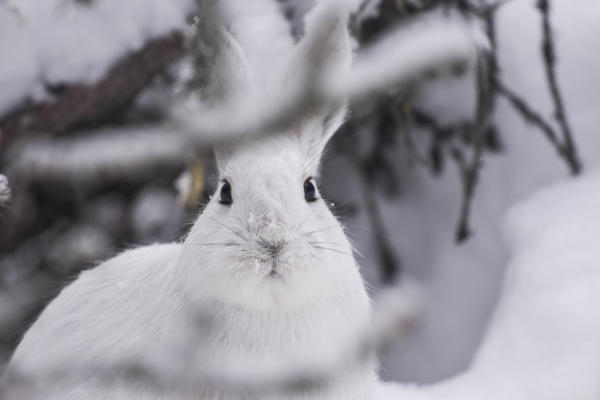Last updated: April 17, 2024
Lesson Plan
Snowshoe Hare Population Cycles in Denali

- Grade Level:
- Middle School: Sixth Grade through Eighth Grade
- Subject:
- Science
- Lesson Duration:
- 60 Minutes
- State Standards:
- MS-LS2-2, MS-LS1-4, MS-LS1-5, MS-LS2-1, MS-LS2-4
Essential Question
How do scientists estimate the size of wildlife populations and predict how population sizes may change over time?
Objective
Students learn how scientists study snowshoe hare populations in Denali National Park and Preserve, analyze recent population trends, and predict future population changes.
Background
There are many ways to study animals. One way to learn about an animal is to study the size of its population. A population is the number of animals of the same species in an area. For example, a forest might have a population of red squirrels, or a lake might have a population of trout. Populations can fluctuate, or change over time, due to limiting factors. These are environmental conditions that affect an animal’s survival, such as the amount of food and water or the number of predators.
Snowshoe hares (Lepus americanus) are small mammals in the rabbit family that are common in the spruce forests of North America. Their name comes from their large hind feet that act like snowshoes, allowing them to stay on top of the snow.
Snowshoe hare populations are known for fluctuating, or going up and down, over time. Some years conditions support a large population of hares and you’ll see them every day, while other years there are few hares and seeing one is a big treat!
Snowshoe hares are an important food source for many predators, including owls, goshawks, eagles, and lynx. Knowing if snowshoe hare populations are high or low allows scientists to predict the population sizes of their predators. For example, scientists have observed that the number of lynx in Denali often decreases a year or two after the number of snowshoe hares declines, and increases when snowshoe hares become more abundant. In other words, snowshoe hare population sizes are a limiting factor for lynx populations.
Park scientists wanted to learn more about the pattern of the population fluctuations of snowshoe hares in Denali. Is there a certain number of years between the rise and fall of the population sizes? They began to study how many hares there were in certain study locations to look for patterns.
Preparation
Have the Student Handout (below) available for each student.
Materials
Procedure
- Distribute the Student Handout (linked above).
- Read through the background information. It may be useful to read this together as a class.
- Allow 30–40 minutes for students to work through the data analysis and questions.
- (Optional) Allow 15 minutes for a discussion of their answers to the “next steps as a scientist" questions.
Additional Resources
Snowshoe Hares — National Park Service webpage about the biology of snowshoe hares, including information on their diet, habitat, reproduction, and survival techniques.
What Goes Up Must Come Down: The Influence of Climate on Caribou Populations - Frontiers for Young Minds — Online article for students by National Park Service Wildlife Biologist, Kyle Joly. Learn about an example of another wildlife species in Alaska that experiences population fluctuations.
